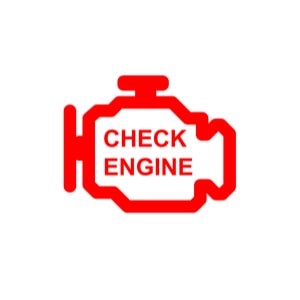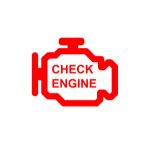There can be a lot of things going on when the check engine light is on. The problem can be due to a single source or can even be from multiple issues manifesting themselves in a single symptom.
In that case, you could either be looking at spending a few bucks for a replacement which you can do yourself; or an expensive repairs like a catalytic converter replacement.
Once the problem has been determined, the price of the repair itself depends on the gravity of the damage, what component is damaged, and the brand of the equipment suitable for your car.
Check Engine Light Diagnostic Cost
The average cost of check engine light diagnostic and servicing is around $90.
The price is inclusive of services like a complete testing of the engine, the replacement parts of the car that cause the check engine light signal, labor fee, and a test drive. The price also includes a final report with recommendations and what kind of repair was performed on the vehicle, depending on the findings.
Prices can vary depending on different factors; the first being each auto shop and dealership offering different packages and services. Some may also charge higher depending on their location due to the cost of living and the cost of doing business in different states which mainly affects the labor rate.
Another factor would be the car’s make, model, age, and its engine. Naturally, an older car will most likely have more trouble and the diagnostic process will be more meticulous and will require more time and effort. The same goes for sports cars that have a more powerful and complicated engine design.
Check Engine Light Diagnostic Test and Process
Every car has a check engine light indicator on the dashboard as a part of the On-Board Diagnostic or the OBD.
In most modern vehicles, there are two ways the light flashes when there is a problem with the engine or any mechanical parts of the vehicle. Because of this technology, it can be easy for drivers – even those without the technical knowledge of engine and repair, to initially diagnose the problem of their vehicles without any professional help.
When the check engine light is blinking, it means that a major problem has occurred in the engine that needs to be addressed immediately. If the light is steady, you can use the car as it is but you need to schedule a diagnostic test with your nearest and trusted mechanic the soonest time possible.
Initially, mechanics will ask owners for complaints about any unusual experience they had with the car such as misfires, fuel inefficiency, and poor engine performance. This way, they know which part of the engine to check right away and they will have an idea of how the inspection is done.
The mechanics will then conduct a visual inspection to determine the possible problem of the vehicle based on the answers and observations of the owner.
Once the visual inspection was done, the mechanics will then conduct a few more tests on potential problems on fuel pressure, spark plugs, and the whole engine compartment. After the testing, they will then recommend the best repair option needed for the specific problem observed.

Common Reasons Why Check Engine Light is On
Usually, the check engine light turns on after the car shows symptoms such as engine rumbling too loud, sudden high fuel consumption, and the likes. Furthermore, these symptoms can be due to common or severe mechanical issues such as a loose or damaged gas cap, engine misfire, and oxygen sensor problems.
- Engine Misfire
A misfiring engine is most commonly due to one of the failing cylinders in the combustion system. When this happens, the car’s ignition may not do its job properly, causing the engine to fail to start and lose power.
Aside from problems in the combustion system or a faulty spark plug, especially in gas engines, other reasons why an engine misfires can be due to a bad fuel delivery system, vacuum leak, and a full mechanical breakdown.
When it comes to the budget, the engine misfire repair cost may depend on the severity of the problem observed by the mechanic. For a faulty spark plug, however, it’s usually fixable with a replacement that is fortunately fairly easy to address.
If you know a mechanic friend who can do the labor for you, or if you know how to replace spark plugs, you can get them online for a price of around $10 a piece or $45 for a pack of four. Of course, these prices can vary depending on the type of car you own and the brand of the equipment you are buying.
- Fuel Cap Problems
Although this issue may be considered as minor, having a loose cap can make your car less fuel-efficient, making you spend more on fuel while the engine is put under more stress – causing it to lose power, especially if this issue is ignored.
Fortunately, a loose, worn out, or damaged fuel cap is easy to find out and repair. First, open your fuel cap and do an inspection. See if the gasket is worn out or if the cap itself is rusty. Check the brand and the specifications of the fuel cap on your car, so you know what to buy and what is suitable as a replacement.
Otherwise, if you didn’t find any obvious signs of wear, make sure to close the cap and listen to the click. Turn on the engine and wait for the check engine light to turn off. If it does, then the problem should be solved.
Fuel caps can be purchased at around $10 to $50 each while the labor fee is around $70.
- Malfunctioning Oxygen Sensor
The O2 sensor is one of the crucial parts of the exhaust system of a vehicle. The sensor is responsible for determining how much oxygen is being pushed out from the engine; whether if it’s too lean or too rich, and it also works hand-in-hand with the catalytic converter in the process of filtering the air out of the exhaust.
Furthermore, the process that the O2 sensor does is that it helps keep the engine more fuel-efficient by calculating how much oxygen is being exhausted from the engine.
Typically, the cost to replace the engine’s oxygen sensor is around $60 to more than $400 and the labor fee is around $70 on the average.
- Failing Catalytic Converter
The catalytic converter is part of the exhaust or the emission control system responsible in helping to reduce emissions produced by the vehicle. Inside it contains chemicals and filters that look like a honeycomb that converts harmful gases such as carbon monoxide into a more environmentally friendly exhaust emission.
A failing catalytic converter can be due to various reasons such as negligence or poor maintenance, overheating, contamination or clogging, physical damage, and old age.
When the catalytic converter fails, the engine will become sluggish and the exhaust will become loud and will emit dark smoke with a nasty smell like that of rotten eggs. Also, the floor of the car may feel hot due to the cat converter overheating.
Furthermore, you may have a hard time starting the engine or it may not even start at all. On the other hand, if you manage to make the car run, once you drive, you will notice that you’d have to fill up the tank more often than you used to and the engine will not run as smooth as it should.
If you want to check the cat converter yourself, one of the best and effective ways to do it is by using a vacuum gauge. The vacuum gauge is also helpful to identify problems on other components like the MAF or the O2 sensor that may show the same symptoms as a failing catalytic converter.
The cost of catalytic converter replacement for parts alone can range from as low as $70 to as high as $3,000 or more depending on the materials, the source of the parts, and the year, make, and model of your vehicle.
- Mass Airflow Sensor Problems
The MAF sensor is responsible for determining the amount, mass, and temperature of the air coming into the engine through the ECU to be able to measure the right amount of fuel that the fuel-injector will inject to keep a good air and fuel balance.
Unlike the O2 sensor which determines the amount of oxygen coming out of the engine by burning a portion of it before coming out from the exhaust system, the MAF sensor is responsible for determining the air coming inside the engine to ensure that the engine uses a sufficient amount of fuel to keep its efficiency.
When the MAF sensor is having issues, one thing you will notice is that the engine loses its fuel efficiency. The vehicle will idle roughly and the engine will sometimes misfire due to the imbalance ratio of air and fuel in the engine.
The mass airflow sensor replacement can cost roughly around $200 to $300 for the parts and labor fee.
Other Tips on What to Do When Check Engine Light is On
Vehicle problems can range from different reasons and the check engine light is a very helpful tool for owners in determining any issues in the engine that need to be checked out.
When the check engine light turns on, do your own assessment before going to the nearest mechanic. Check for symptoms of engine trouble or damage through a series of tests that you can do yourself.
Listen to how your engine runs while idle and driving. Check if the gas cap is intact or if there are signs of damage.
On the other hand, get a vehicle inspection every once in a while; at least once every six months or once a year. Since not every car problem can be a DIY project unless you are a mechanic or you have a lot of free time, professional help always comes in very handy, especially if you want to make sure you get the best out of your vehicle.

